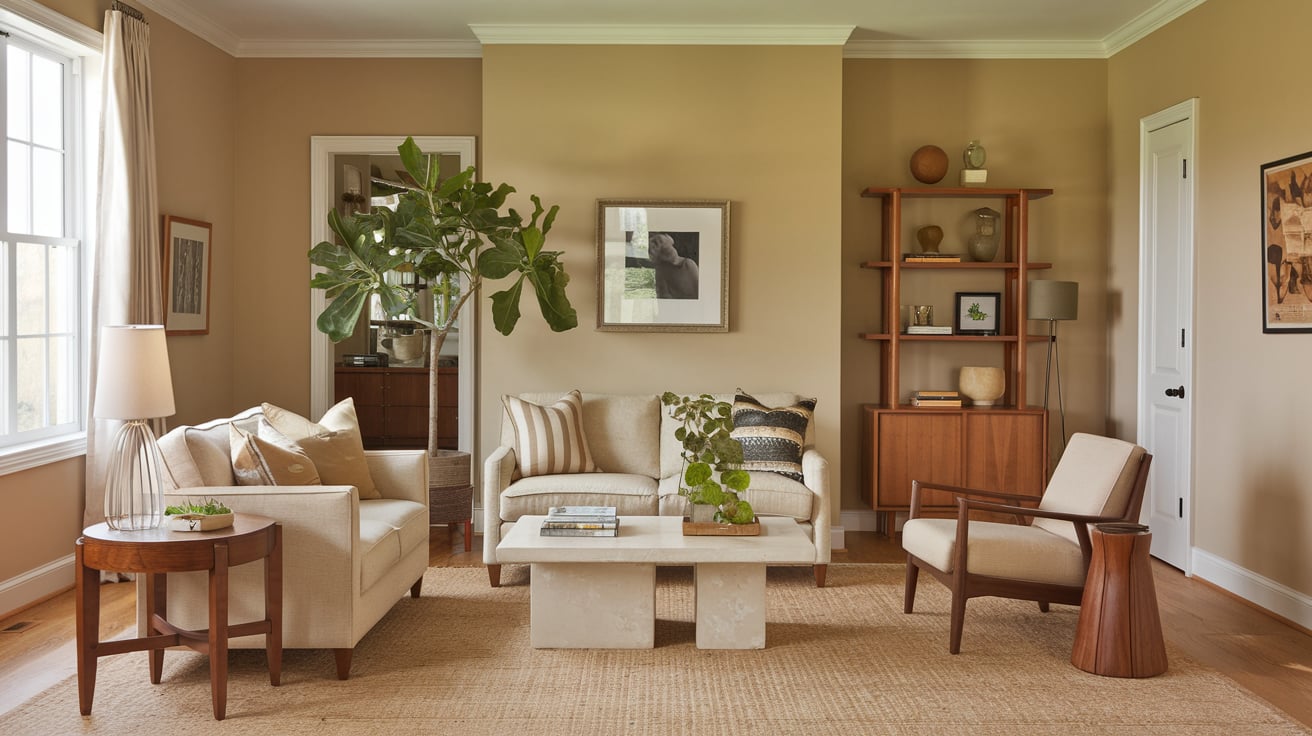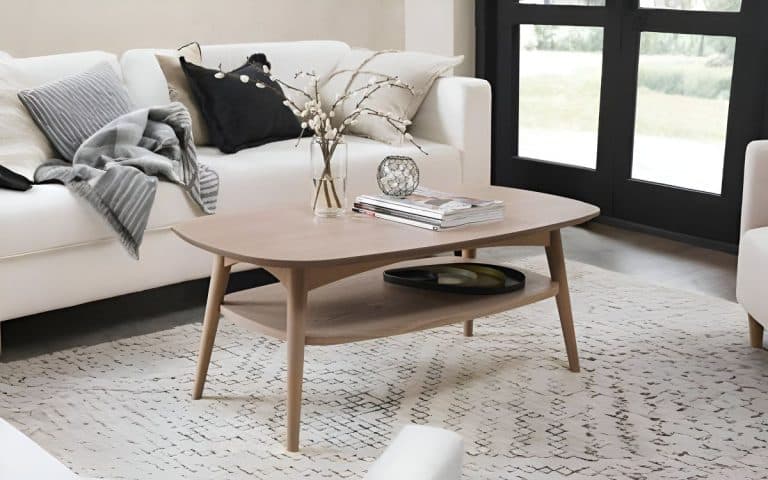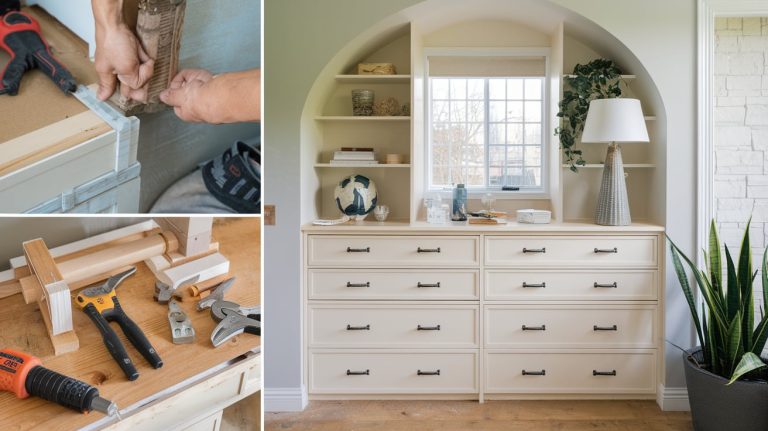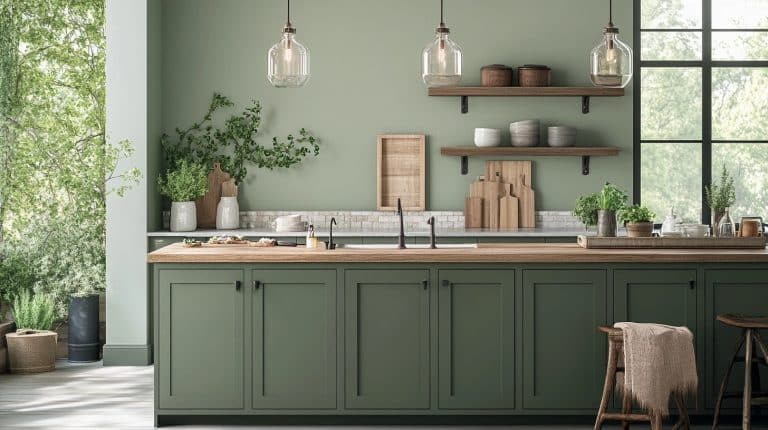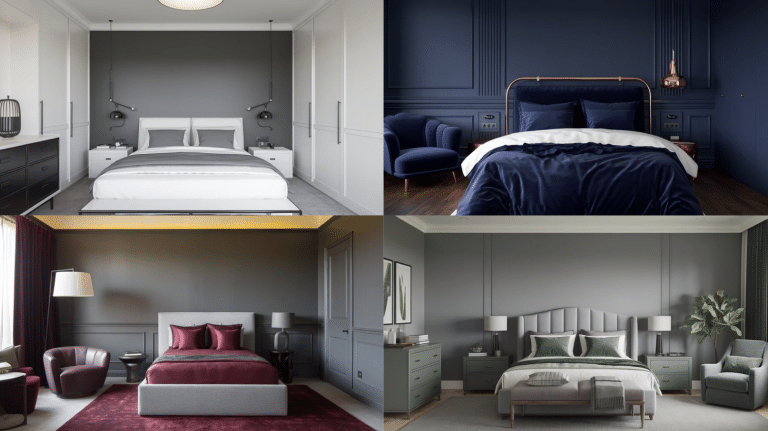Exploring Manchester Tan: Grace in Art & Design
In today’s post, I’ll explain everything about Benjamin Moore’s Manchester Tan, a warm beige perfect for creating cozy, livable spaces in your home.
I’ve spent years helping homeowners choose paint colors, and Manchester Tan has always been reliable.
This color has helped transform over 200 rooms I’ve worked on, from sunny living rooms to basement spaces that needed brightening up.
Are you ready to see if this versatile neutral suits your home?
Let’s explore what makes Manchester Tan such a sought-after choice.
What Makes Manchester Tan Special?
Manchester Tan is a balanced beige paint color that works wonderfully in various lighting conditions. Its unique ability to maintain warmth without being too yellow or pink sets it apart.
As a neutral shade, it creates a comfortable backdrop that doesn’t compete with furniture or decor.
Many homeowners appreciate how it brings a gentle warmth to their spaces without feeling overwhelming.
Light Reflective Value (LRV) and Its Impact
With an LRV of 64, Manchester Tan is light enough to brighten a room while maintaining enough depth to provide noticeable color.
This number reflects a good amount of light back into your space.
In practical terms, painting a room with Manchester Tan will not make it look washed out in bright areas, and it can help make dimly lit spaces feel more open and airy.
The moderate LRV also means it photographs well and maintains character throughout the day.
Undertones and Color Behavior
Manchester Tan’s subtle green undertones help it stay neutral and adaptable.
These undertones become more apparent than other beiges, keeping them from feeling too warm or cool.
You might notice a slightly warmer appearance in morning light, while the afternoon sun brings out its balanced nature.
The green undertones make it especially good at complementing your home’s warm and cool color schemes.
Best Use Cases for Manchester Tan
This color shines in multiple applications throughout your home. It’s particularly effective in:
1. Living Rooms
Living rooms where you want to create a welcoming atmosphere
2. Kitchens
Kitchens, where it pairs beautifully with both white cabinets and wooden elements
3. Home Offices
Home offices that need to feel professional yet comfortable
4. Bedrooms
Bedrooms seeking a calm, restful environment
5. Basements
Basements require a light touch to feel less cave-like
The color works exceptionally well in open floor plans, creating a consistent flow from room to room without feeling monotonous.
It pairs wonderfully with white trim, making architectural details stand out while maintaining an inviting atmosphere.
Manchester Tan’s beauty lies in its flexibility. It suits traditional and modern design styles, adapts to different lighting conditions, and creates a beautiful foundation for future decor choices.
Comparing Manchester Tan with Similar Shades
1. Muslin vs. Manchester Tan
While both colors have an LRV in the mid-60s, Muslin shows distinct pink undertones compared to Manchester Tan’s green base.
Muslin often reads warmer on walls, while Manchester Tan maintains a more balanced appearance throughout the day.
2. Wool Skein vs. Manchester Tan
Sherwin-Williams’ Wool Skein matches Manchester Tan’s LRV and shares similar green undertones. The main difference?
Manchester Tan appears slightly crisper, making it more adaptable to modern spaces, while Wool Skein leans into a softer, more traditional feel.
3. Edgecomb Gray vs. Manchester Tan
Though they share the same LRV, these colors take different paths.
Edgecomb Gray brings more gray to the mix, creating a cooler feel. Manchester Tan stays committed to its warm character while maintaining those subtle green undertones.
4. Revere Pewter vs. Manchester Tan
These colors make excellent neighbors in an open floor plan. Revere Pewter brings more gray and depth, while Manchester Tan offers lightness and warmth.
They complement each other beautifully, especially in transitional spaces.
Ideal Color Pairings with Manchester Tan
1. Best White Trim Options
- Chantilly Lace: Creates clean, sharp contrast
- Simply White: Offers a softer transition
- White Dove: Brings warmth without competing
- Oxford White: Provides crisp definition without stark contrast
2. Accent Colors That Complement Manchester Tan
The green undertones in Manchester Tan make it particularly friendly with:
- Rich navy blues for a classic pairing
- Deep forest greens for natural harmony
- Warm browns for layered neutrals
- Charcoal grays for modern contrast
Practical Uses & Design Inspiration
1. Project Spotlight Manchester Tan in an Atrium Living Room
Manchester Tan proved its worth in a Colorado home featuring an indoor pool by seamlessly connecting indoor and outdoor spaces.
The color adapted beautifully to changing natural light throughout the day, complementing the water features and mountain views while maintaining warmth in the spacious area.
2. Manchester Tan in a Zen Bedroom
Manchester Tan created the perfect backdrop for Japanese-inspired decor for a teenage client’s bedroom with Eastern exposure.
The color stayed true from bright mornings to quiet evenings, supporting the calm atmosphere while complementing natural wood furniture and black accents.
3. Using Manchester Tan for Cabinetry
Kitchen cabinets painted in Manchester Tan offer a fresh take on the white kitchen trend. The color adds subtle warmth without overpowering the space.
In a recent project, lower and white upper cabinets in Manchester Tan created visual interest while maintaining a cohesive look.
4. Manchester Tan in Carpeting & Flooring
Manchester Tan proves its versatility as a carpet color. It hides daily wear while creating a neutral foundation for any decor style.
A recent client chose the Manchester Tan carpet for their second floor, which worked perfectly with various wall colors in different rooms. For optimal results, test samples in your specific lighting conditions.
Manchester Tan’s success in these applications comes from its balanced nature; it’s light enough to feel fresh yet warm enough to feel comfortable.
Whether used on walls, cabinets, or floors, it maintains its character while blending well with surrounding elements.
Considerations & Limitations
1. When Manchester Tan May Not Work
While Manchester Tan performs well in many settings, it’s not always the perfect choice.
The green undertones might create an unwanted contrast in rooms with strong purple or pink decor. Very bright, south-facing rooms can sometimes wash out their subtle qualities, making them appear flatter than intended.
Manchester Tan’s undertones might not be the most flattering combination in spaces with violet-gray furnishings or tiles.
It also presents challenges when paired with warm cream trim colors, as the contrast might not be strong enough to create visual interest.
2. Testing Manchester Tan Before Commitment
Please test this color properly before you make your final decision.
Here’s my tried-and-true method:
- Paint large sample boards (at least 24×24 inches) rather than small swatches
- View the color during different times of the day
- Check how it looks with your existing furniture and fixtures
- Move the sample around to different walls in your space
- Compare it against your trim color in both natural and artificial light
Peel-and-stick samples are the most reliable way to test Manchester Tan. These pre-painted, movable swatches show true color and save you the mess of sample pots.
They also allow you to easily place the color next to your existing elements to ensure everything works together.
Observe how the color shifts throughout the day in your specific space. Morning light, afternoon sun, and evening shadows can all affect how Manchester Tan appears on your walls.
Conclusion
Manchester Tan continues to be a reliable choice for those seeking a warm, adaptable neutral for their homes.
Its balanced nature, with an LRV of 64 and subtle green undertones, makes it uniquely suited for various spaces and lighting conditions.
This color creates welcoming environments that stand the test of time, from cozy bedrooms to spacious living areas.
Through my years of color consulting, I’ve seen Manchester Tan bring warmth to modern spaces and fresh energy to traditional homes.
While it may not suit every situation, its ability to work with various whites, blend with natural elements, and maintain its character in different lighting makes it a worthy consideration for your next paint project.

